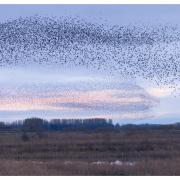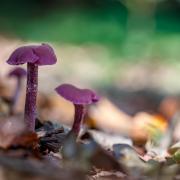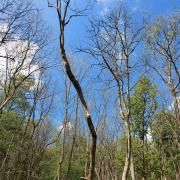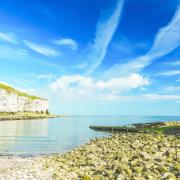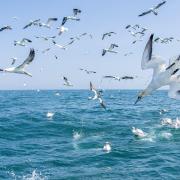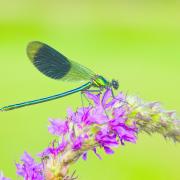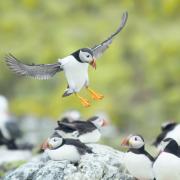Photographer Tom Marshall shares some top tips on how to get the perfect pictures of Yorkshire’s wildlife

The nature photographers of yesteryear would no doubt be gobsmacked at the photographic technology at our disposal today. Lightweight telephoto lenses, the capability to shoot in near darkness, and perhaps the most revolutionary change of all: the digital era.
Across more than two decades as a nature lover, beginning in the early 1990s, I have had my hands on the full spectrum of ‘gear’. From a silvery chromed, fully manual SLR inherited from my father, through to the first clunky incarnations of digital cameras in the 2000s, to smartphones and the latest ground-breaking professional lenses available today.
Whatever the advances, thankfully the basic principles of taking a good wildlife picture have remained largely untouched. Today’s equipment simply enhances these options or gives you more chance to try ideas out – without the need to change a film in a panic-stricken moment of wildlife magic!
Below are just a few tips for the next time you’re out and about in the Yorkshire countryside, but most important of all, remember that the wildlife comes first – no picture is ever worth forcing a change in a creature’s behaviour or risking its safety.

How low can you go?
When it comes to capturing wildlife on film (or memory card) it’s often the simplest rules that can make the biggest different to your shots. The most common – and yet blissfully simple aspect – that for me still shows the difference between a good image and a great image, is seeing a creature on their terms.
You wouldn’t take a standard family photo from 30ft in the air (unless a drone was on your Christmas list), but that’s just what it’s like if you take a photograph of a duck, flower or butterfly from above. As humans we broadly spend our lives eye-to-eye, and that’s what helps our understanding of each other – and it’s no different with our wildlife.
So whether it’s an orchid, a friendly fox or just the wildfowl on a local lake, get down to your subject’s level. Most cameras today have terrific shutter speeds or ‘image stabilisation’, but if you still need a steady hand, then a backpack or waterproof will do to keep the gear shake-free. Getting on the level will bring you straight into the animal’s world – and instantly you feel like you’re witnessing things from their perspective.

The eyes have it
The perfect partner to getting face-to-face with your subject is eye contact. While there’s always a place for that wistful look into the middle distance, you can’t beat another pair of beady eyes staring back to grab your attention.
This of course can be an added challenge with nature providing an array of faces; from the head-on stare of an owl, to mammals whose eyes are placed on their side of their heads for increased predator awareness.
The other holy grail of eye contact is what’s known as a ‘catch light’, the moment when the sun, or just the ambient brightness, reflects off the shiny surface of the eye giving a bright white spot. This can require split-second timing as the creature turns at a particular angle, but it can be the difference to help a shot really come alive.

It’s all a blur
Previously the preserve of the SLR camera owner or professional, the opportunity to change the aperture – the amount of light entering the camera – or ‘f number’, is now available on almost any good quality camera, including compact and ‘bridge’ systems.
Often shown as an ‘A’ button (Aperture priority), the smaller the number, the less light available to the lens. As a result, if you focus firmly on your subject (don’t forget those eyes), then much of the background should be captured as a pleasing blur of colour. This is a classic wildlife photography technique, and quickly brings your attention to the important part of the shot.
Useful for a wide range of wildlife, this simple step can be particularly satisfying with flowers, butterflies and other insects, helping to showcase their minute detail. The effect can also be extenuated by slightly adjusting your position to keep the background as far from the subject as possible, and getting as close as you can. A good rule of thumb for general wildlife would be to go no higher than f4-f5.6.

The rule of thirds (but there to be broken)
The human mind is a wonderfully imaginative and curious thing, and looking at a photograph is no different.
Take a bird in flight or scampering deer – we sense a feeling of movement then we start to imagine where that animal is going, and we can do that much better by giving it some ‘space’ to fly into in the photograph.
This phenomenon is often referred to as the ‘rule of thirds’, with research suggesting that breaking an image into three makes it more appealing to us visually, and takes our eyes to where they naturally want to go (not necessarily the centre for example).

The Golden Hour
You may often hear photographers refer to the ‘golden hour’ – better known as the period just before sunset or just after sunrise. Unlike the harsher, bleaching ‘white’ heat of the middle of the day (especially in summer), these periods offer a stunning range of yellows, oranges and more to play with.
As well as more atmospheric and emotive scene-setting, the lower position of the sun can help for that all-important catch light, and can accentuate features such as the antlers of a deer or the ears of a hare with a little creative backlighting.
Crucially, when the midday sun can make black and white creatures a real challenge, the golden hour provides softer and more forgiving conditions to work with.

What about smartphones?
Although digital SLR (Single Lens Reflex) cameras remain the choice of the keenest wildlife photographers and professionals, today’s remarkably high resolution smartphones also offer plenty of opportunity.
‘Macro’ settings allow you to get close to subjects such as flowers or insects
In-built panoramic options are often much easier than on larger SLR cameras
Environmental portraits – showing a creature smaller in the frame (so less need for a zoom) to acknowledge its habitat are becoming more sought-after
‘Digi-scoping’ – attaching a smartphone to birdwatching equipment to create a ‘budget’ telephoto lens is creating better results than ever
Filters – perhaps best used sparingly, the instant ability to turn an image to black and white can create dramatic impacts with more charismatic species like large mammals
Flexibility – a bag of high-end camera gear could weigh several kilos, but with a smartphone you’re always ready for action!
As with anything in life, practice makes perfect so remember these tips when the next wildlife watching opportunity presents itself. Take your time, take care and be patient. What’s not caught on film will always be retained in memory, so in that sense you have nothing to lose.
Be sure to share your best results with us online in Yorkshire’s biggest and best gallery of contemporary photography. Andy O’Brien’s photos which are featured in this article were uploaded to our reader photo gallery.
Go to the photos section and click on the ‘Upload a Photo’ tab to add your efforts.












